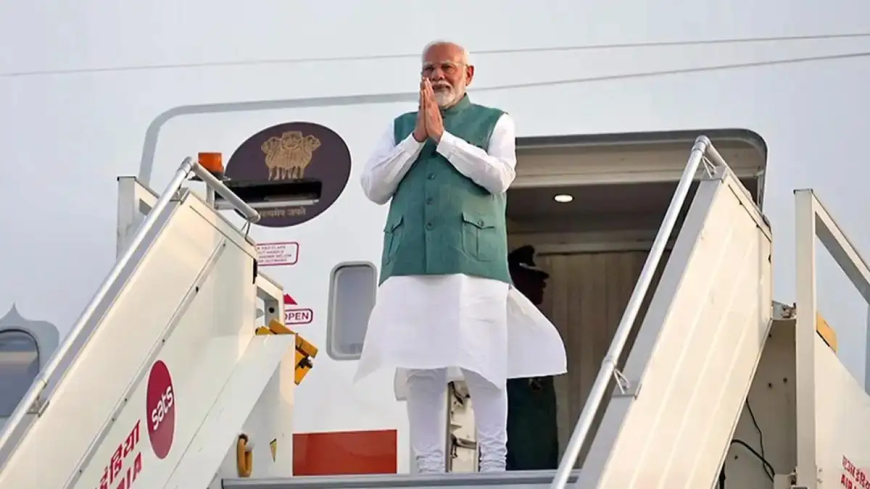Modi’s Global Power Play: Inside the Prime Minister’s High-Stakes 8-Day Diplomatic Marathon
Prime Minister Narendra Modi embarks on a strategic 8-day global tour spanning Russia, Austria, and Central Asia, aiming to strengthen defense ties, energy security, and global diplomacy.

New Delhi — A Tour with Purpose, Precision, and Global Optics
Prime Minister Narendra Modi’s ambitious 8-day global tour, launched on July 1, has stirred both admiration and analysis across international diplomatic circles. Covering Russia, Austria, and Central Asia, the tightly packed itinerary is not just about optics—it’s about strategic recalibration, energy diplomacy, and geopolitical signaling at a time when global alliances are shifting.
This marks Modi’s first multilateral overseas visit of 2025, coming at a time when India is positioning itself as a pole of stability in an increasingly fragmented global order.
"India is not just a participant in global affairs—it is now a shaping force," said a senior official from the Ministry of External Affairs during a press briefing before the tour began.
Read the official MEA statement on the PM’s itinerary.
Stop 1: Moscow, Russia — Strategic Balancing Amid War and Sanctions
Modi’s first stop was Moscow, where he met with Russian President Vladimir Putin. Despite ongoing international scrutiny over Russia’s actions in Ukraine, India has maintained a deliberate neutrality, balancing its ties with both Russia and the West.
During the two-day summit, Modi reaffirmed India’s commitment to long-term defense cooperation while also pushing for diversification beyond arms.
Key Takeaways:
-
Joint commitment to localizing defense production under "Make in India"
-
Talks on securing long-term crude oil contracts at discounted rates
-
Proposal for rupee-ruble payment mechanisms to avoid dollar dependencies
Russia remains India’s largest arms supplier and a major energy partner. However, the visit also signals India’s ability to navigate complex alliances without compromising national interests.
For a comprehensive look at India-Russia ties, read this detailed policy analysis by Carnegie India.
Stop 2: Vienna, Austria — A Historic First in Over Four Decades
Modi’s next destination, Vienna, marked a historic moment—it’s the first Indian prime ministerial visit to Austria in over 41 years. The stop was rich in symbolism and practical diplomacy.
Highlights of the Austria Visit:
-
Signing of green hydrogen collaboration agreements
-
Expansion of the India-Austria Technology Innovation Fund
-
Cultural diplomacy with a large Indian diaspora event in Vienna
Austria, a neutral European nation, plays a unique role in multilateral diplomacy, especially on nuclear disarmament and sustainable technology. Modi’s focus here was to position India as a responsible power willing to collaborate on clean energy and AI governance.
“We may not share borders, but we do share values—democracy, innovation, and multilateralism,” Modi said during his joint statement with Austrian Chancellor Karl Nehammer.
Explore the Austria-India technology collaboration report on the Austrian Federal Ministry for Climate Action.
Stop 3: Central Asia Outreach — Energy, Security, and the INSTC
The final leg of the trip involved virtual summits and in-person dialogues with leaders from Central Asia, particularly Kazakhstan, Uzbekistan, and Turkmenistan.
The main focus here was to strengthen India’s footprint in the International North-South Transport Corridor (INSTC) and bolster energy ties through the TAPI gas pipeline and uranium sourcing agreements.
Key Initiatives:
-
Agreement on expanding Chabahar Port connectivity
-
Joint military training exercises with Kazakhstan and Kyrgyzstan
-
Bilateral MoUs on rare earth mineral exploration in Uzbekistan
India’s engagement with Central Asia is increasingly critical as China’s Belt and Road Initiative continues to influence the region. Modi’s outreach here is designed to offer an alternative model based on transparency and shared growth.
For context on India’s strategic vision in the region, read ORF’s Central Asia strategy brief.
The Global Optics: Modi as a Statesman of the Global South
The 8-day tour is being projected by many analysts as an effort to reinforce India’s leadership of the Global South. Modi has carefully curated a narrative of being both a regional heavyweight and a constructive global player, especially in times when the West is grappling with internal divisions.
Diplomatic observers note that the tour also served as a soft power strategy, combining political engagement with diaspora outreach, innovation diplomacy, and symbolic optics.
Reactions at Home and Abroad
While supporters of the Modi government hail the tour as a masterclass in foreign policy execution, opposition leaders have criticized the lack of transparency on defense deals and energy negotiations.
“Foreign policy must be a tool for national development, not just personal branding,” said Congress leader Rahul Gandhi on X (formerly Twitter), reflecting on the PM’s public receptions in Vienna and Moscow.
International media outlets such as Bloomberg and BBC have noted that Modi's balancing act could serve as a template for middle powers in managing East-West tensions.
Conclusion: Diplomacy with Direction
Prime Minister Narendra Modi’s 8-day global tour was not a ceremonial journey—it was a strategic, forward-looking mission aimed at diversifying India’s global partnerships in a multipolar world. From energy deals in Moscow to tech collaboration in Vienna and connectivity corridors in Central Asia, the trip has added multiple layers to India's foreign policy depth.
As India prepares for major summits such as BRICS+, G20 follow-ups, and COP30, this tour will likely serve as a diplomatic foundation that the country builds on through the rest of the year.














